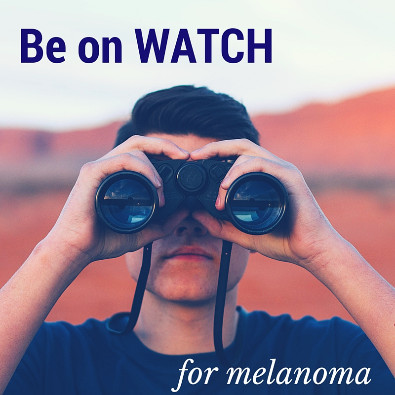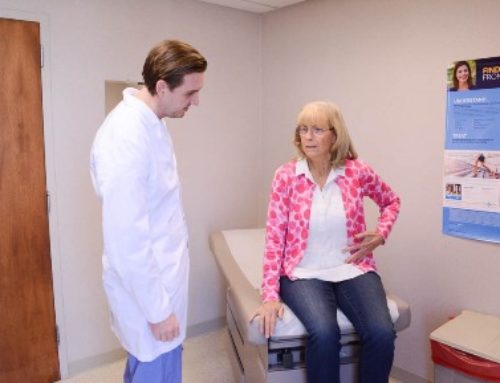DID YOU KNOW THAT SKIN CANCER IS THE MOST COMMON FORM OF CANCER IN THE UNITED STATES?
Each year, there are more new skin cancer cases than breast, prostate, lung and colon cancers combined. Melanoma is the most serious type of skin cancer, and it develops in the cells that produce melanin (or the pigment that gives your skin its color). Although the exact cause is unknown, UV radiation exposure – like the kind you get from prolonged sunbathing or tanning bed use – can increase your risk.
Melanoma is different than other skin cancers. Even in its early stages, it has the potential spread throughout the body’s lymph system and occasionally through the whole body by means of the bloodstream. It may also occur in oral, vaginal, anal, nasal and intestinal mucus membranes. Sometimes melanoma’s primary lesion resolves without a trace, leaving cancerous cells inside the body. That’s why a seemingly small lesion can be potentially devastating and hard to treat if it’s ignored.

“When a melanoma reaches four millimeters in depth, it’s very hard to cure. In these instances, it can spread to anywhere in the body – the brain, lungs, bones, skin and intestines,” says Alvaro Valle, M.D., oncologic and breast surgery specialist at University Surgical Associates. “The good news is that melanoma can be cured if it’s discovered early. The difference between a non-aggressive melanoma and a VERY aggressive melanoma is only a few millimeters in depth. The difference on the outside can seem small, but the depth under the skin determines if the cancer is likely to be cured.”
What type of lesion is a cause for concern?
Any lesion or group of lesions that are preexisting or not, that are changing, bleeding, painful, growing – these merit an evaluation by your physician.
There are many tools your physician may use to determine if a lesion is cancerous, including its appearance on eye exam, dermoscopy (an imaging tool that screens the skin surface for abnormalities), and other similar devices, ultimately a biopsy may be indicated. Dr. Valle encourages everyone to stay vigilant about changing moles or lesions on their body. Sometimes skin changes can be addressed before they become malignant (or cancerous). In many cases, a person’s spouse or hairdresser is in the best position to find a cancerous lesion early.
“You don’t want to wait until a lesion has all these features, but instead talk to your doctor when you have early signs that can be addressed more easily. Pre-malignant skin lesions are less dangerous,” Dr. Valle says. “One way to stay on top of skin changes is to have a close family member look at your skin closely and regularly. They’ll be able to see more quickly if something isn’t right.”
There’s a simple way to evaluate your skin. Remember the ABCDE rule to help identify suspicious looking moles:
A – Asymmetry (One half of the mole doesn’t match the other).
B – Border that is irregular, scalloped or poorly defined.
C – Color that is not uniform; has shades or tan, brown or black and is some time white, blue or red.
D – Diameter greater than 6 mm (about the size of a pencil eraser).
E – Evolving shape, size or color.
Learn more about the ABCDEs here.
“A dermatologist’s evaluation is crucial on an ongoing basis, however because of the limited number of dermatologists in the community, it’s also important to have a strong relationship with a primary care physician and ask them to do a skin check whenever you have a checkup or physical,” Dr. Valle says. “If you spot something unusual on your skin, don’t wait. Talk to you doctor right away. It could save your life.”





It stood out to me when you mentioned that melanoma is the most serious type of skin cancer. Are you at risk of developing skin cancer if you live near a nuclear power plant? It seems like it would be a good idea to speak to a cancer expert so that you can learn more about living in an area like this.
I recently heard about my relative suspecting that she has melanoma cancer since she has painful lesions on her body. Thank you for explaining to us that melanoma is the most serious type of skin cancer since it has the potential to spread throughout the body’s lymph system and throughout the whole body through the bloodstream. I hope my relative sees a dermatologist soon for her treatment right away.
It’s been a tough time lately; my friend got diagnosed with melanoma, and it hit us all like a ton of bricks. The idea of someone so vibrant dealing with something as serious as skin cancer is just heartbreaking so I’m on this mission to help her find the right melanoma treatment because she deserves every chance to kick this thing to the curb. I do not even wanna think about what you said here on how a melanoma that has grown to a depth of four millimeters is extremely difficult to treat since it can spread to any part of the body, including the brain, lungs, bones, skin, and intestines.